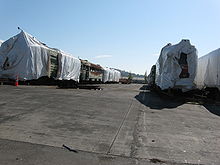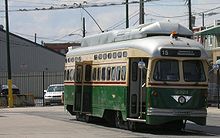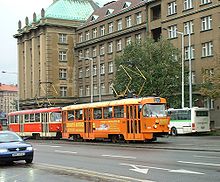- PCC streetcar
-
PCC streetcar 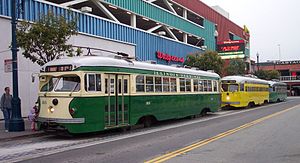
Three PCCs on the San Francisco Municipal Railway's F-line. An example of one double-ended streetcar and two former SEPTA cars.
Interior of a PCC carIn service 1936–present Manufacturer St. Louis Car Company
Pullman-StandardConstructed 1936–1952 Scrapped 1950s–1998 Number built 5000 Capacity 52–61 Seats Specifications Car length 46–50.5 ft (14.0–15.4 m) Maximum speed 50 mph (80 km/h) Weight 35,000–42,000 lb (15,900–19,100 kg) Acceleration Variable, Automatic 1.5–4.75-mph/s Deceleration Service: Variable to 4.75 mph/s,
Emergency: 9.0 mph/s maximumTraction system 4 x 55 hp (41 kW) motors, 43:6 (~7.17) gear ratio Electric system(s) 600 V DC Braking system(s) Dynamic Service Braking; Friction for Final Stop, Park; Magnetic Gauge Wide, Standard, Narrow Gauges The PCC (Presidents’ Conference Committee) streetcar (tram) design was first built in the United States in the 1930s. The design proved successful in its native country, and after World War II was licensed for use elsewhere in the world. The PCC car has proved to be a long-lasting icon of streetcar design, and PCC cars are still in service in various places around the world.
Contents
Origins
The PCC name comes from the design committee formed in 1929 representing the Presidents of various electric street railways. The Electric Railway Presidents’ Conference Committee, or ERPCC, was tasked with producing a new type of streetcar that would help fend off competition from buses and automobiles.[citation needed] The committee conducted extensive research, prepared a detailed research program, built and tested components, made necessary modifications, and produced a high-performance design that was commonly used in the following decades.[citation needed] The cars were popular because of their distinctive streamlined design and smooth acceleration and braking. The design patents were held by a business called the Transit Research Corporation, who licensed features to various streetcar manufacturers.[citation needed]
It turned out that the PCC streetcar was a very good design. The standard car was 46 ft (14.0 m) long and 100 in (2.54 m) wide with later models 46.5 ft (14.2 m) long and 108 in (2.74 m) wide.[citation needed] Chicago, Detroit, Illinois Terminal, Pacific Electric, and San Francisco had longer cars, as long as 50.5 ft (15.4 m).[citation needed] Washington, D.C., had shorter cars (44 ft (13.4 m)) because of transfer table clearances.[citation needed] Many railways altered the car in various ways to fit their own needs, but most cars retained a standard appearance.
Although a participant in Committee meetings, trolley manufacturer J. G. Brill and Company brought a competitive design—the Brilliner—to market in 1938. With Raymond Loewy designed elements, very similar to the PCC look, the Brilliner attracted no large orders, serving most conspicuously with Atlantic City Transit. Fewer than 50 were sold.[1]
A significant contribution to the PCC design was Noise Reduction with extensive use of rubber in springs and other components to prevent rattle, vibration, and thus noise and to provide a level of comfort not known before.[citation needed] Wheel tires were mounted between rubber sandwiches and were thus electrically isolated so that shunts were used to complete ground. Resilient wheels were used on most PCC cars with later heftier cousins known as Super-Resilient.[2]
Gears were another source of considerable noise, solved by employing hypoid gears which are mounted at a right angle to the axle, where three of the six teeth constantly engaged the main gear, reducing play and noise. All movable truck parts employed rubber for noise reduction as well.[3] "Satisfactory Cushion Wheel of Vital Importance; Develop New Truck Design; Generous Use of Rubber" are headings within a paper that Chief Engineer Hirshfeld both presented and published.[4]
Pittsburgh Railways (PRCo) took delivery of PCC #100 in June 1936, the fourth order for a PCC car but the first PCC car delivered and the first in revenue service in the world.[5][6] Production continued in North America until the early 1950s, with 4978 units built; thousands more PCCs and direct descendants were produced in Europe through the 20th century. The cars were very sturdy and many lasted a long time; well into the 1970s the majority of surviving North American streetcar systems used PCC cars, the systems which closed often selling their cars secondhand to the surviving operators. A handful still remain in service alongside modern vehicles, though most of the PCC cars functional today are operated by museums and heritage railways.
The first order of 99 cars was built in 1936 for Brooklyn, New York, by the St. Louis Car Company.[citation needed] The second order built (27) was for Baltimore and the third order went to Chicago, all by St. Louis Car Company.[citation needed] Clark Equipment Company built only one PCC, #1000, and the only aluminum PCC at that;[citation needed] this car completed the 100-car order for Brooklyn.
Washington, DC, PCCs were unique[citation needed] because of conduit plows which collected current from a slot between the rails into which the plow dipped, contacting positive and negative rails under the street on either side. At the city limits were "plow pits", where the plow was dropped and removed, the trolley pole raised, and the car then continued on its way, utilizing overhead wire; the process was reversed in the opposite direction into Washington.
"The PCC car was not just another modular vehicle but the result of the only systems engineering approach to mass producing a rail car."[7] Research into passenger comfort resulting from vibrations, acceleration, lighting, heating and cooling, seat spacing, cushion height, space for arms, legs, standing passengers, economies of weight affecting maintenance, cost of power, reduced wear of components and track. Dimensions were established to fit the majority but could easily be changed for special situations. Windows were spaced to match seating.[8]
While some of the components in the PCC car had been used before—resilient wheels, magnetic braking, sealed gears, and modular design to name a few—the ERPCC redesigned, refined, and perfected many of these while developing new acceleration and braking controls and put them all in one package. The PCC is far more than a good design, it is an excellent design with modern transit rail vehicles essentially upgrading the design with the most recent technology.[citation needed]
Manufacturing
United States
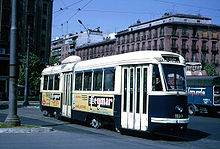 Spanish-built Fiat/PCC running in Madrid in 1969
Spanish-built Fiat/PCC running in Madrid in 1969
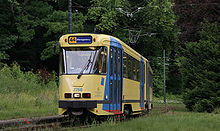 Later European versions, like this model in Brussels, had a boxier shape.
Later European versions, like this model in Brussels, had a boxier shape.
PCC cars were initially built in the United States by the St. Louis Car Company (SLCCo) and Pullman Standard. Clark Equipment built the only aluminum-body PCC as well as all narrow gauge B1 trucks for Los Angeles, all the standard and wide gauge B2 trucks both air- and all-electric, and the B2B trucks used under PRCo 1725–1799 and Toronto 4500–4549.[citation needed] SLCCo built all B3 trucks, both standard and wide gauge.[citation needed] PCC cars for Canadian cities were assembled in Montreal, Quebec by Canadian Car and Foundry from bodies and trucks supplied by St. Louis Car.[9]
Westinghouse Electric, Westinghouse Air Brake, and General Electric supplied the electrical packages and brake components which were designed and built in cooperation with the ERPCC.[citation needed] The customer specified which equipment to install. Since Westinghouse was home based near Pittsburgh, PRCo ordered 75% of its PCC fleet with Westinghouse equipment, the balance with GE.[citation needed] Indeed, PCCs are often identified as either Westinghouse or GE.[clarification needed]
Europe
The PCC technology was exported to Europe, with La Brugeoise et Nivelles (now the BN division of Bombardier) of Bruges, Belgium, building several hundred streetcars that saw service in Brussels, Antwerp, Ghent, The Hague, Saint-Étienne, Marseille and Belgrade (the latter city buying vehicles initially used by the Belgian Vicinal railways).
The first European PCC cars were probably the ones developed in 1942 by Italian Fiat for the Madrid tramway system. Due to the progression of World War II, delivery of the units from Italy had to be stopped (Tranvías de Madrid pp. 228) and eventually 110 cars were built in Spain to the Fiat design, either by CAF (Compañía Auxiliar de Ferrocarriles) in Beasain or MMC (Material Móvil y Construcciones) in Zaragoza. These units worked very successfully in Madrid until May 1972 (Tranvías de Madrid pp. 177).
CKD Tatra of Prague also bought a PCC license, and built 18,680 PCC-based streetcars of the T1, T2, T3 and T4 models.(Refer Wikipedia articles on these trams.) Most numerous was type Tatra T3; 14,113 units were sold worldwide, mainly in former eastern bloc countries. ČKD Tatra had begun marketing to the rest of the world until 2000, when the company faced a bankruptcy and reorganization. The tram business was sold to Siemens SKV, who discontinued these products. Variants and reconstructions of T3 cars (usually with low-floor centre sections) continue to be manufactured by Czech tram-builders such as Skoda subsidiary Pars Nova and Pragoimex. The Tatra PCCs are by far the most numerous PCCs in the world.
Another Central European company producing PCC cars (though not licensed) was Polish Konstal in Chorzów, Upper Silesia.[citation needed] The Konstal 13N type was a copy of the CKD Tatra T1[citation needed] (but with Belgian electric equipment) and is still used in Warsaw. Newer Konstal 105N types, produced since 1973, had the PCC electrical set. After many modernizations, the upgraded type Konstal 105Na and later versions based on it are still produced (though with modern electronic equipment) by Konstal, which was bought by Alstom in 1997. 105Na generation cars are still used in all tram-towns in Poland.[citation needed]
Last PCC streetcars
The last PCC streetcars built for any North American system were a batch of 25 for the San Francisco Municipal Railway, manufactured by the St. Louis Car Company and delivered in 1951-2.[10]
Performance
Westinghouse developed the XD-323 rotary accelerator with 99 points; it was installed in the first PRCo car, #100, and minor modifications allowed use in the last PCCs produced in North America for San Francisco in 1952. Resistance ribbons were mounted to each point around the outside edge of the accelerator. An arm rotating in the center had rollers on either end which cut out resistance alternately as it rotated approximately 180 degrees. This same accelerator was also used for dynamic braking; when the power pedal was released the accelerator sought optimum braking for the speed, which prevented a lag when the brake pedal was depressed. General Electric Developed a control system for PCC cars that mirrored the Westinghouse scheme in function, although not in simplicity or maintainability.[11] With the GE commutator motor controller operating by air pressure, it had to be redesigned with the advent of the All-Electric PCC. Acceleration was variable between 1.5- and 4.75-mph per second depending upon the depression of the power pedal with the accelerator advanced automatically by a low-voltage pilot motor. Service braking was also variable and the maximum dynamic application decreased speed by 4.75-mph/s; pressing the brake pedal into emergency also brought the friction and magnetic brakes into play providing a maximum deceleration of 9.0-mph/s. Compared to a maximum of 14 points on old time equipment, the PCC was considerably smoother.
Most PCCs employed three pedals with a dead man's switch to the left, brake in center, and power pedal on the right. Depressing the brake about half way and then releasing the deadman pedal put the PCC in "park". Lifting the deadman alone would apply all brakes, drop sand, and balance the doors so they could be pushed open easily. Chicago used "bicycle-type levers" for power and brake but converted some cars to two pedals.[12] (SLPS) used two pedals, both with heel interlocks. The right pedal is the brake; depressing this pedal about half way while lifting away from the heel applied "park". Once the brake is released the heel need not be engaged with the interlock (although a professional driver is to cover the brake at all times.) The left pedal applied the power and the heel interlock had to be engaged at all times since it was the deadman; only when the brake was in "park" could the deadman be disengaged.
SLPS is unique in that all 300 of their PCCs are All-Electric with the 1500s ordered in late 1939, the 1600s ordered late 1940s and the 1700s in January 1945. SLPS was the rolling laboratory for All-Electrics and what was learned here was applied to the post-WW2 All-Electric Demonstrator in the Fall of 1945.
From 1936 to 1945, PCC cars were 'Air-Electrics' with friction brakes, doors, and windshield wipers operated by air pressure. PRCo PCC 1600 of 1945 was the post WW2 All-Electric Demonstrator[13] which eliminated the air compressor and associated piping while incorporating such features as standee windows, a sloped windshield to eliminate night time glare, redesigned back end, forced-air ventilation, and other features. Dynamic brakes were the service brake on all PCCs; when almost stopped, friction brakes completed the stop and held the car in "park". Dynamic brakes slowed the "Air" cars to 3.0-mph at which point a lock-out relay allowed automatic application of air-applied friction brakes against each of the eight wheels. On All-Electric cars the dynamics were effective to 0.75-mph where the lockout relay then allowed a spring applied friction brake to engage a drum on each of the four motor drive shafts; this completed the stop and held the car in park. Drum brakes were released by an electric solenoid operating from low-voltage battery power; a power failure would prevent the drums from releasing which would prevent power application, a fail-safe feature. Drum brakes were quite popular and greatly reduced maintenance thus some "Air" cars were retrofitted with drums. Four magnetic brakes, one between the wheels on each side of each truck, applied additional braking for emergency stopping where all brakes were generally employed.
"These performances [acceleration and braking] enable the P.C.C. car to out-pace the average automobile which, in America, is of substantially higher performance than the typical British vehicle."[14]
Largest fleets
 A PCC streetcar in operation on the Toronto Transit Commission's 509 Harbourfront line.
A PCC streetcar in operation on the Toronto Transit Commission's 509 Harbourfront line.
The following are known figures (2008.09.13):
City New Used Total Notes Moscow 2,249 Tatra T2 180. Tatra T3 2,069. Other Russian/former Soviet Union cities, other than those listed below, had 20 Tatra T1s, 200 Tatra T2s and 7,398 Tatra T3s. Warsaw approx 1,399 Tatra T1 2. Konstal 13N 836. Konstal 105N approx 560. Approx 400 other Konstal 105N were deployed across other cities in Poland. The Konstal designs were not produced under a PCC licence. The 13N was based on the Tatra T1; the 105N used PCC equipment. Prague 1,328 Tatra T1 133. Tatra T2 2. Tatra T3 1193. Other Czech and Slovak cities had 132 Tatra T1s, 389 Tatra T2s and 1061 Tatra T3s. Another 365 Tatra T3s were delivered to German cities apart from those listed below and 313 to other eastern European countries including former Yugoslavia, Romania and Latvia. Another 954 Tatra T4s were delivered to cities in eastern European countries including former Yugoslavia, Romania and Latvia. Kiev 923 Tatra T3. Leipzig 870 Tatra T4. Dresden 822 Tatra T4. Toronto Transportation Commission 540 225 765 All new PCCs purchased by 1951; second-hand by 1957.[15][16] - TTC now owns and operates only two PCCs for private charter: numbers 4500 and 4549.
Kharkiv 735 Tatra T3. Chicago 683 683 Total in 1948. Many were converted to CTA 6000 and 1-50 series rapid transit cars by 1958.[15] One is preserved at the Illinois Railway Museum in operating condition.[17] Pittsburgh 666 666 Total in 1949. Philadelphia Rapid Transit Company 470 90 560 All new PCCs purchased by 1947; second-hand by 1955.[15][19] - SEPTA purchased 30 ex-TTC/Kansas City Public Service Company class A-14 PCCs in 1976.
- SEPTA owns and operates 18 PCC II cars for regular revenue service, all rebuilt since 2003 by Brookville Equipment Corporation.
Halle 447 Tatra T4. Magdeburg 416 Tatra T4. Brussels, Belgium 361 The Hague, Netherlands 264 The actual GTL-8 articulated trams are based on PCC-techniques and some of them still drive on recuperated bogies of demolished PCC's. Antwerp, Belgium 165 Some are still in service. Figures for Tatra trams are from Wikipedia articles on the respective tram models.
PCCs still in active service
North America
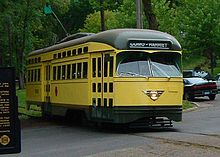 A Twin City Rapid Transit PCC streetcar in museum operation.
A Twin City Rapid Transit PCC streetcar in museum operation. San Francisco Municipal Railway #1061, a rebuilt PCC streetcar painted in honor of the Pacific Electric Railway, is seen in service on the F Market heritage line in December, 2004. This single-ended car was originally built for the City of Philadelphia in 1946. (Pacific Electric only operated double-ended PCCs.)
San Francisco Municipal Railway #1061, a rebuilt PCC streetcar painted in honor of the Pacific Electric Railway, is seen in service on the F Market heritage line in December, 2004. This single-ended car was originally built for the City of Philadelphia in 1946. (Pacific Electric only operated double-ended PCCs.)
In North America, most PCC-based systems were dismantled in the post-war period in favor of bus-based transit networks. Of the rail transit systems that survived this period, most had replaced their PCCs with modern light rail vehicles (LRVs) by the early 1980s. A few sites have only recently concluded operation with PCCs:
- The first PCC cars in Canada were operated by the Toronto Transit Commission (TTC) in 1937. By 1954 Toronto had the largest PCC fleet in the world, including many purchased second-hand from U.S. cities that abandoned streetcar service following the Second World War. Although it acquired new custom-designed streetcars in the late 1970s and 1980s, the TTC continued using PCCs in regular service until the mid-1990s, and retains two (#4500 and #4549) for charter purposes. These vehicles occasionally enter revenue service to mark special occasions. Recently they have been showcased on the 509 Harbourfront route on weekends during the summer. A number of different models of Toronto PCC cars are on display at the Ontario Electric Railway Historical Society museum, the Halton County Radial Railway, near Rockwood, Ontario. Several are in operating condition and rides are available to the public. Toronto sold their earlier PCCs to Alexandria, Egypt from 1966 to 1968. These cars remained in operation until 1984.
- The Newark City Subway used them until upgrading to modern LRVs in 2001.
- The unique Tandy Center Subway in Fort Worth, Texas, shut down in 2002. A shuttle between a mall and its parking lot, the system used a number of PCCs, but their exteriors were heavily modified in the 1970s, making them largely unrecognizable.
As of 2005, there are still a few places in North America where transit agencies employ PCCs in true revenue service (as opposed to short-run or intermittent heritage railway service). Of these, only one has been in service continuously since the PCC's glory days:
- The Ashmont-Mattapan High Speed Line in Boston is a light-rail extension of the MBTA's heavy Red Line. It runs from the Ashmont terminus of the Red Line to Mattapan, and runs PCCs exclusively. The line was shut down for reconstruction from June 24, 2006 until December 22, 2007, but PCC cars have resumed operation since the line's bridges cannot support heavier light rail vehicles (LRV) operated on the MBTA's Green Line.
Not considered historic equipment, the PCC cars in use on the Mattapan-Ashmont line represent the oldest cars still in revenue service, originally built between 1943 and 1946. These cars are also the only air-electric PCCs still in regular service in North America. Several retired PCCs from Boston are now at the Seashore Trolley Museum.
Beginning in the late 1990s, several cities began to make use of historic PCCs to serve historic streetcar lines that combined aspects of tourist attractions and transit:
- The F Market Line (historic streetcar service) in San Francisco, opened in 1995, runs along Market Street from The Castro to the Ferry Building, then along the Embarcadero north and west to Fisherman's Wharf. This line is run by a mixture of PCC cars built between 1946 and 1952, and earlier pre-PCC cars. (Although San Francisco had removed PCCs from revenue service when the city's light rail was transformed into the Muni Metro system in 1980, they had made occasional festival trips in the ensuing years before being returned to full-time service.). Car 1074 is painted in the livery of the Toronto Transportation Commission, but this car was never in the TTC roster.
- The Kenosha Electric Streetcar in Kenosha, Wisconsin, has been operating five PCCs acquired from Toronto since 2000. The Kenosha Electric Streetcar is unique among modern PCC operations in that that PCCs had not run in the city before 2000—the original rail system was shut down in 1932 before any PCC cars had been built. One of its cars is still painted in its original TTC colours, while the rest have been re-decorated in the liveries of several U.S. cities including Pittsburgh, Johnstown, Chicago and Cincinnati.
- SEPTA restored trolley service to the Route 15 Girard Avenue line in Philadelphia in September 2005 after a 15-year "temporary" suspension of trolley service in favor of diesel buses. The line uses restored and modernized (by the Brookville Manufacturing Company) PCC cars, known as PCC-II's, painted in their original green and cream Philadelphia Transit Company livery, rather than SEPTA's white with red and blue stripes. Modernization included all-new control systems, modern turn markers, HVAC system (which accounts for the noticeably larger roof enclosure), and ADA compliant wheelchair lifts. The line runs from Haddington to Port Richmond down the median of Girard Avenue. It crosses both the Broad Street Subway and the Market-Frankford Line, and stops at the Philadelphia Zoo, among other landmarks. SEPTA had originally planned to run modern Kawasaki trolleys along the line once service was restored, but a combination of economics and a desire to help revive the Girard Avenue corridor with a more "romantic" vehicle led to the agency restoring the old vehicles for about half the cost of new cars.[citation needed] SEPTA uses Kawasaki vehicles on the rest of its trolley lines, including the Subway-Surface Green Line linking West Philadelphia with Center City and its 69th Street Terminal with the western suburbs of Media and Sharon Hill via the Media-Sharon Hill Line.
- One of the PCC cars from the Tandy Center Subway was acquired by McKinney Avenue Transit Authority in Dallas, Texas. Prior to 1977, it was rebuilt and given a boxy, more symmetrical appearance. When the McKinney Avenue Transit Authority bought the PCC car in February 2003, it was named "Winnie" for its resemblance to a Winnebago.
As many cities contemplate new transit projects, PCC-based streetcar lines are an attractive option as they are relatively low cost and can serve as a tourist attraction in and of themselves, especially on routes through historic city centers.
Europe
Pre-war tram networks remain largely intact in a number of European cities, and many still use PCCs as part or all of their rolling stock. Late-model PCCs remain in use in Belgium. The vehicles used in Antwerp and Ghent are metre-gauge, while those used in Brussels are standard-gauge. One of the peculiarities of the four-axle Brussels PCC vehicles is that some of them have been equipped with bogies and electric motors acquired second-hand in the United States from decommissioned streetcars from Kansas City, Missouri, and Johnstown, Pennsylvania. The last of the originally 171 four-axle class 7000 PCC cars in Brussels were withdrawn on February 12, 2010, with the articulated PCCs (130 class 7700 six-axle cars and 60 class 7900 eight-axle cars) remaining in service.
The tram system of Sofia, Bulgaria has 16 lines totaling 221 km served by 190 trams, some of which are Tatra PCCs. In Romania, Bucharest's extensive tramway network features a large fleet of Tatra T4R PCCs.
The largest number of PCCs (Tatra models) operate in Russia and countries of the former Soviet Union.
Several tramways in the Czech Republic and Slovakia still use Tatra PCC cars, while many in Poland still operate Konstal PCCs. Some in the former East Germany also still use them, but many have been extensively modified.
Gothenburg tram types M25, M28 and M29, delivered between 1958 and 1967 resemble the PCC cars in appearance only, since they are quite different technically.
German manufacturer DUEWAG produced a large number of GT6 and GT8 Streetcars for many German and European cities after 1951. Those cars were basically a modernized version of the PCC car, adapted to the specific requirements of European cities.[20]
Africa
Some PCC trams are still in use in Cairo, Egypt suburban systems, see Trams in Egypt.
Latin America
PCC cars were also exported to Latin America, although not in great numbers, to Mexico and Buenos Aires particularly, in Buenos Aires they ran through exclusive rights of way on the suburban Urquiza Line for a while, these were modified at the ends to operate in two, three or four-sectioned articulated formations like most modern LRVs.[21] See List of town tramway systems in Argentina
See also
- Peter Witt streetcar
- Birney Safety Car
- Citytram
- Toronto PCC-cars Technical Specifications
- Streetcars in North America
- Streetcars in Kenosha, Wisconsin
References
- ^ Brill, Debra (2001). History of the J. G. Brill Company. Indiana University Press. pp. 202–205. ISBN 0253339499.
- ^ Carlson, S.P.; Schneider, F.W. (1980). PCC: The Car That Fought Back. Interurban Press. pp. 114–116. ISBN 0-916374-41-6.
- ^ Carlson & Schneider (1980), pp.117–119.
- ^ C.F.Hirshfeld, Ch.Engr., PCC; (October 1933) "Electric Transit and Bus Journal", pp.321–325, 331.
- ^ Carlson & Schneider (1980), pp. 76, 91 (top photo caption).
- ^ Andrew D. Young, Eugene F. Provenzo (1978). The history of the St. Louis Car Company, "Quality Shops". Howell-North Books. p. 196 (photo caption). ISBN 0831071141.
- ^ Carlson & Schneider (1980), p. 59.
- ^ Carlson & Schneider (1980), pp. 59–61.
- ^ Carlson, S.P.; Schneider, F.W. (1983). PCC: From Coast to Coast. Interurban Press. p. 235. ISBN 0-916374-57-2.
- ^ Kashin, S.; Demoro, H. (1986). An American Original: The PCC Car, p. 79. Glendale (CA): Interurban Press, ISBN 0-916374-73-4.
- ^ Carlson & Schneider (1980), p. 149.
- ^ St. Louis Public Service Co.
- ^ Carlson & Schneider (1980), pp. 98–100.
- ^ H.G. McClean, B.Sc, M.I.E.E., M.I.Loco.E.; December 14, 1945, "Passenger Transport Journal:" The American P.C.C. Car, p. 348.
- ^ a b c d Dr. Harold E. Cox (1963) PCC Cars of North America.
- ^ Toronto's 'Boomer' PCCs
- ^ IRM Roster Page for CTA 4391
- ^ "$400,000 Flash Fire Destroys Homewood Car Barn, 14 Trolleys". The Pittsburgh Press. May 19, 1955. http://news.google.com/newspapers?id=_XobAAAAIBAJ&sjid=3k0EAAAAIBAJ&pg=3013,765597&dq=homewood+fire&hl=en. Retrieved December 8, 2010.
- ^ Philadelphia Trolley Track
- ^ DE:WP: Duewag-Einheitswagen (Duewag Uniform Car)
- ^ Coches Eléctricos para servicios urbanos de la Línea Urquiza (Spanish) includes photo gallery
Further reading
- Carlson et al. (1986), The Colorful Streetcars We Rode, Bulletin 125 of the Central Electric Railfans' Association, Chicago, Il. ISBN 0-915348-25-X
- Kashin, S.; Demoro, H. (1986), An American Original: The PCC Car, Interurban Press, ISBN 0-916374-73-4
- (Spanish) López Bustos, Carlos, Tranvías de Madrid, Aldaba Ediciones, Madrid 1986, ISBN 84-86629-00-4
External links
Categories:- Passenger rail vehicles
- Tram vehicles
- Tram vehicles of Belgium
- Tram vehicles of Canada
- Tram vehicles of Mexico
- Tram vehicles of Spain
- Tram vehicles of the United States
Wikimedia Foundation. 2010.

